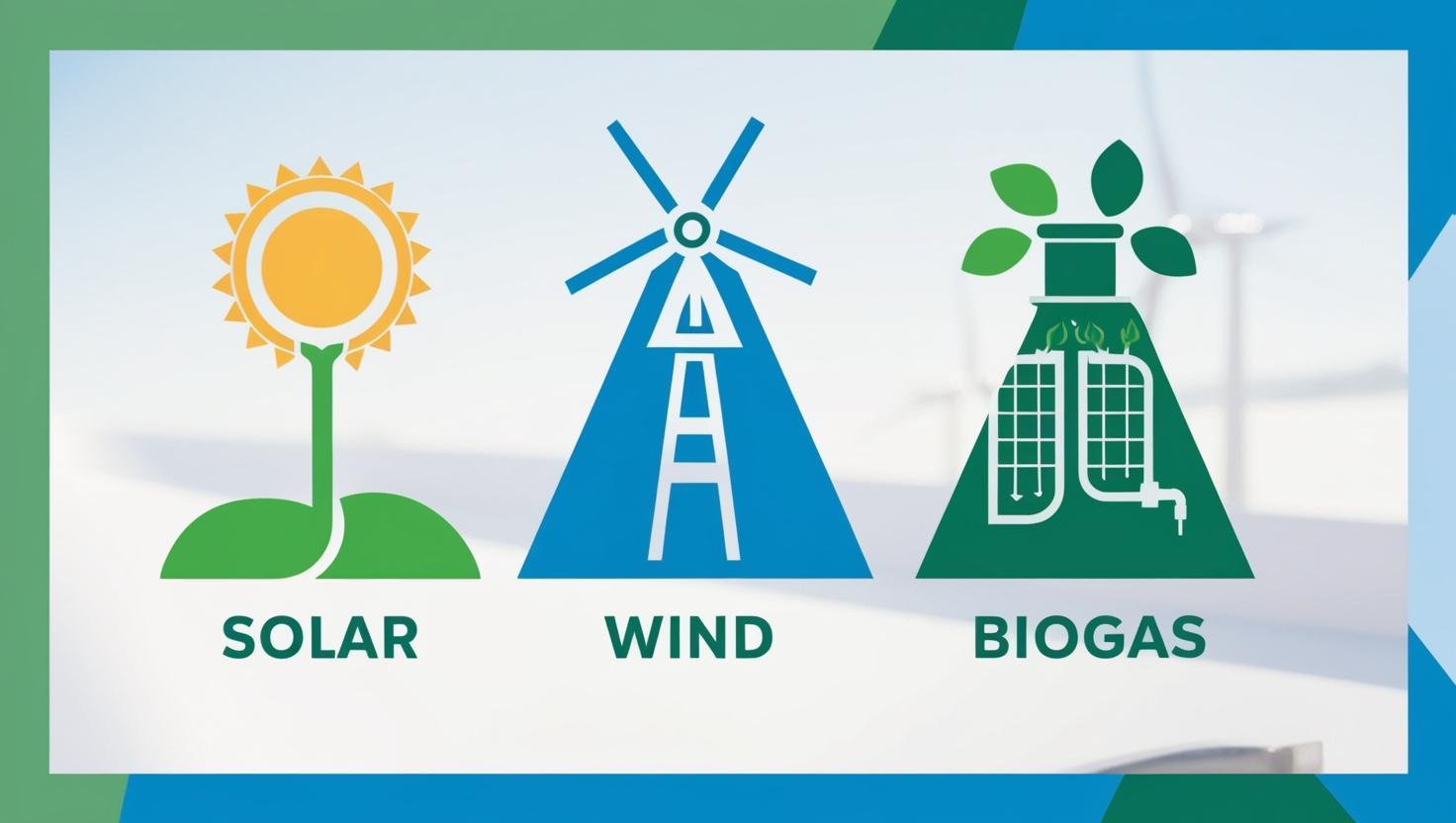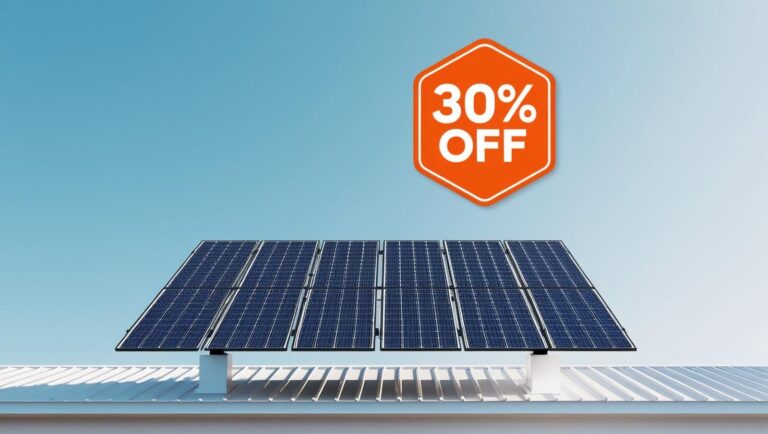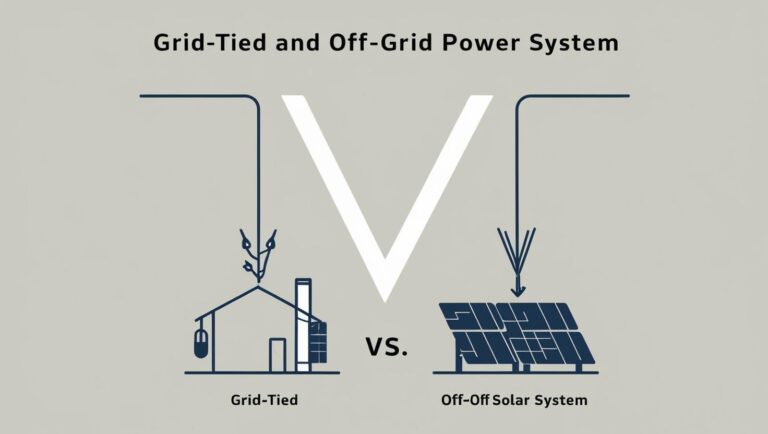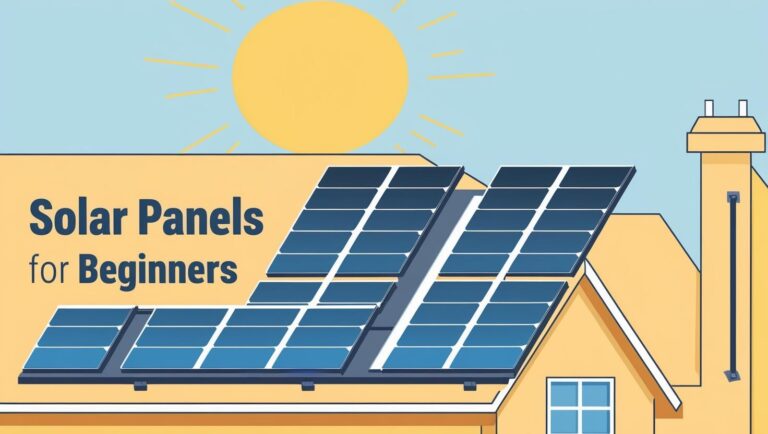Solar vs. Wind vs. Biogas: Which is Right for Your Home?
🌍 Looking to go green but unsure which energy system fits your home? Solar, wind, and biogas each have unique pros and cons. Let’s compare them head-to-head so you can make an informed choice.
(For a broader energy independence strategy, see our DIY Home Energy Systems Guide.)
🟠 Quick Answer:
Solar suits most homes, wind needs acreage + consistent breeze, biogas excels for farms with waste. Hybrid systems (solar+wind) offer the most reliability but cost 20-30% more than single-source systems.
1. Solar Energy: The Plug-and-Play Option
Sunlight is the world’s most accessible renewable resource—and solar panels make it remarkably easy to harness. As the fastest-growing home energy solution (with installations increasing 23% yearly since 2020, per SEIA), solar excels where other systems struggle: urban spaces, modest budgets, and DIY-friendly setups.
The magic lies in simplicity: Unlike wind or biogas requiring specific conditions, solar works anywhere with 4+ peak sun hours (that’s most of the continental U.S.). Modern panels now convert 22-23% of sunlight to energy—up from 15% a decade ago—making them viable even in cloudy regions like the Pacific Northwest.
☀️ How It Works
Solar panels convert sunlight into electricity via photovoltaic cells.
✅ Pros:
- Low maintenance (just occasional cleaning).
- Scalable (start small, expand later).
- Incentives available (tax credits, net metering).
❌ Cons:
- Weather-dependent (40-60% output drop on cloudy days).
- Space needs (requires unshaded roof/land).
🔗 New to solar? Calculate your needs with our Solar Panels for Beginners Guide.
Best For: Suburban/urban homes, sunny climates, and homeowners seeking quick ROI (5-8 years with incentives).
📊 Solar Reality Check:
- 1 kW solar produces ~1,200-2,000 kWh/year (varies by location)
- Typical home needs 5-10 kW system (25-50 panels)
- Use NREL’s PVWatts for precise estimates
📊 Wind Reality Check:
- 1.5 kW turbine needs ~10 mph average winds
- Produces ~2,000-4,000 kWh/year in good locations
- Check DOE Wind Maps for your area
📊 Biogas Reality Check:
- 1 cow’s manure = ~2 kWh/day of biogas
- Average home needs 5-10 cows’ worth of waste
- See EPA AgSTAR for digester sizing
2. Wind Energy: Power for Wide-Open Spaces
Wind turbines harness an ancient energy source with modern efficiency, converting breeze into electricity at utility-scale output. While solar dominates urban areas, wind shines where properties have 1+ acres of open land and consistent 10+ mph winds (Class 3 or higher on the DOE Wind Resource Map).
The math is compelling: A single 5kW turbine can generate 8,000-12,000 kWh annually in ideal locations—enough to power most homes. New vertical-axis designs (like the Quietrevolution) now solve traditional wind hurdles, offering:
✔ Lower noise (45dB vs. 55dB in horizontal turbines)
✔ Tighter zoning compliance (under 30ft height)
🌬️ How It Works
Turbines convert wind kinetic energy into electricity through rotor blades spinning a generator.
✅ Pros:
- High output in windy areas (2-3x more daily energy than solar in plains/coasts)
- 24/7 potential (produces at night if wind blows)
- Low operating costs after installation
❌ Cons:
- Needs 10+ mph average winds (fails in urban/suburban “wind shadows”)
- Zoning headaches (many counties ban turbines over 35ft)
- Upfront cost (15k−15k−50k for 5-15kW systems)
🔗 Already have solar? See how hybrid solar-wind systems maximize reliability.
Best For: Rural properties, farms, or coastal homes with clear acreage and minimal height restrictions.
| Factor | Solar | Wind | Biogas |
|---|---|---|---|
| Best Climate | Sunny regions (4+ peak sun hours) | Coastal/plains (10+ mph winds) | Any (with organic waste) |
| Maintenance Frequency | Annual panel cleaning | Quarterly inspections | Daily feedstock management |
| Space Needed | 100 sq ft per kW | 1+ acre clearance | Land + waste storage |
3. Biogas: The Circular Economy Champion
Biogas turns waste problems into energy solutions—literally converting manure, food scraps, and crop residues into renewable power. While often overlooked, the EPA estimates a single dairy cow’s waste can produce 2.5 kWh daily—enough to power a refrigerator. This makes biogas uniquely valuable for:
✔ Farms with livestock (5+ cows ideal)
✔ Off-grid homesteads seeking waste disposal + energy
✔ Climate-conscious owners (reduces methane emissions by 90% vs. open decomposition)
Modern systems are surprisingly sophisticated: Small-scale digesters like HomeBiogas now fit suburban yards, processing 6L of food waste daily into 2 hours of cooking gas. Larger systems can power entire farms, with payback periods as low as 5-7 years for dairy operations (USDA data).
♻️ How It Works
Anaerobic digesters break down organic waste into:
- Methane (for cooking/electricity)
- Digestate (nutrient-rich fertilizer byproduct)
✅ Pros:
- Dual benefit: Energy production + waste reduction
- Weather-proof: Works in all conditions (unlike solar/wind)
- Carbon negative: Prevents methane release from decomposing waste
❌ Cons:
- High upfront cost: 20k–20k–100k for whole-home systems
- Labor intensive: Daily feedstock management required
- Regulatory hurdles: Often needs agricultural zoning
🔗 For off-grid setups, explore our DIY Energy Systems Guide to pair biogas with solar.
Best For: Off-grid farms, homesteads with livestock or high organic waste (50+ lbs/day).
Real-World Examples
🏡 Vermont Off-Grid Home
- 10 kW solar + 1m³ biogas digester
- Handles food waste from 4-person household
- Year-round operation (batteries for winter)
🌾 Texas Cattle Ranch
- 15 kW wind + 5 kW solar
- Offsets 90% of grid usage
- 30% tax credit applied
4. Key Considerations
- Cost: Solar (10k–10k–20k) < Wind (15k–15k–50k) < Biogas (20k–20k–100k).
- Space: Solar (roof) < Biogas (land + waste storage) < Wind (1+ acres).
- ROI: Solar (5–10 yrs) < Wind (8–15 yrs) < Biogas (10+ yrs).
(See HTML section for a detailed comparison table.)
How Grid-Tied vs. Off-Grid Solar Works
🔌 Grid-Tied System
1. Solar panels generate DC electricity.
2. Inverter converts DC → AC for home use.
3. Excess power flows back to the grid (net metering).
4. Grid power supplements when solar is low.
☀️ → ⚡ → 🏠
⚡ → 🏢 (Grid)
🏢 (Grid) → 🏠 (at night)
🏡 Off-Grid System
1. Solar panels generate DC electricity.
2. Charge controller regulates battery charging.
3. Battery bank stores energy for later use.
4. Inverter powers home appliances (DC → AC).
5. Backup generator (optional) for cloudy days.
☀️ → ⚡ → 🔋
🔋 → 🏠 (24/7 power)
⛽ → 🏠 (if generator used)
5. Hybrid Systems: Mix & Match
Pair solar + wind for 24/7 generation, or add biogas for waste-to-energy.
💡 Already off-grid? Optimize with tips from our Grid-Tied vs. Off-Grid Guide.
► Can I combine solar and wind at home?
Yes! Hybrid systems maximize reliability but require batteries to store excess energy. A typical setup might include 3-5kW solar with a 1kW wind turbine for nighttime generation. Design carefully to match your local sun/wind patterns.
► Which system has the lowest maintenance?
Solar wins here—just occasional panel cleaning (2-4 times/year). Wind turbines need quarterly bearing checks and annual professional inspections. Biogas systems require daily feedstock management and weekly digester maintenance.
► Does biogas smell bad?
Modern, properly sealed digesters minimize odors significantly. While open compost piles can smell, closed anaerobic systems contain methane effectively. Odor is typically only noticeable during feedstock loading if the system is well-designed.
► How much wind is needed for a home turbine?
You’ll need consistent 10+ mph winds (Class 3 wind resource) for viability. Turbines typically require at least 1 acre of open land, mounted 30+ feet above obstacles. Use the DOE Wind Resource Map to check your area’s potential.
► Can solar work in cloudy climates?
Yes, but with reduced output (about 10-25% of rated capacity on overcast days). Modern panels work in diffuse light, but you’ll need to oversize your system by 30-50% compared to sunny regions. Pairing with batteries helps overcome intermittency.
► What’s the lifespan comparison?
Solar: 25-30 years (panels), 10-15 years (inverters)
Wind: 20-25 years (turbines)
Biogas: 15-20 years (digesters)
All systems require component replacements over time.
► Which is most space-efficient?
Solar is the most space-flexible, working on roofs or small yards (100 sq ft per kW). Wind needs clear acreage (rule of thumb: turbine height × 10 in all directions). Biogas requires both equipment space and land for feedstock storage/processing.
► Are permits required for these systems?
Solar: Typically needs electrical/building permits
Wind: Often requires zoning variances (height/noise)
Biogas: May need environmental/safety approvals
Always check local regulations – requirements vary significantly by location.
► Can I sell excess energy back to the grid?
Solar: Usually eligible for net metering
Wind: Sometimes allowed (varies by utility)
Biogas: Rarely possible unless converted to grid-compatible electricity
Always check with your local utility provider for specific programs.
► Which works best in power outages?
Only off-grid systems with battery storage or biogas with gas storage provide outage protection. Standard grid-tied systems shut off during outages for safety unless they have battery backups. Hybrid systems offer the most reliability.




